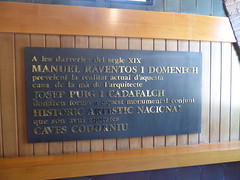Commemorated on 1 plaque
A les darreroes del segle XIX Manuel Raventos I Domenech preveíent la realitat actual d'aquesta casa de la mà de l'arquitecte Josep Puig I Cadafalch donaren forna a aquest monumental conjunt Historic Artistic Nacional que són avui aquestes Caves Codorniu
English translation: In the late nineteenth century Manuel Raventos I Domenech foreseeing the present reality of this one house of the architect's hand Josep Puig I Cadafalch Give this monumental set together Historic National Artistic What are these today? Caves Codorniu
Caves Codorníu - Carrer Can Codorniu, Sant Sadurní d'Anoia, Spain where they designed

